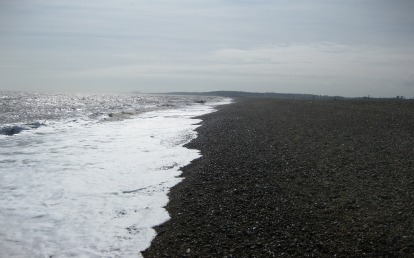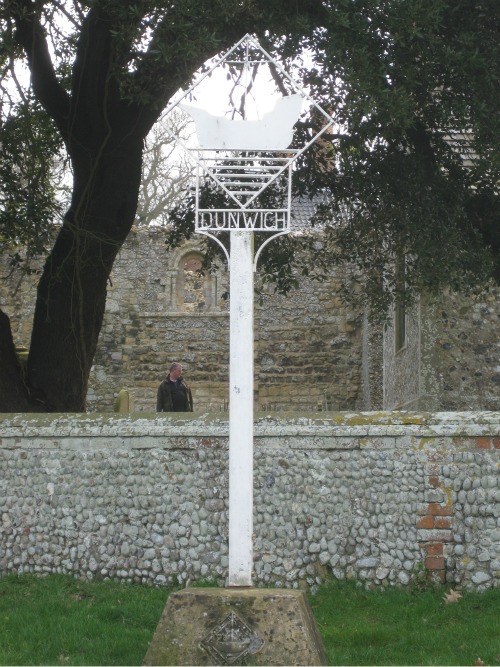In this three-part series, Orchard Times scribe Oscar Rickett investigates the history of Dunwich: Britain’s wannabe Atlantis.
Myths of lost cities abound in our culture. In low lying communities, campfire fables of flooding and destruction are easily interwoven with catastrophes whose histories survive off the modicum of truth that first spawned them. The most striking example of such a story in Britain can be found in the village of Dunwich, in Suffolk.
Dunwich sits on sandy cliffs whose sides have been continually cut away at their bases, causing them to collapse. Over the centuries this coastal erosion has destroyed the Roman settlement, Saxon city and medieval port that once claimed the peninsula. In a few hundred years, no fewer than eight churches fell off the cliffs at Dunwich and into the sea. On a stormy night, so the myth goes, you can still hear the bells ringing under the waves.
First Impressions
I set out from London and, like so many commuters, headed east from Liverpool Street Station. Unlike them, I went all the way to the sea. Passengers drop off the further along you get, stepping out at sleeper towns in Essex and then piling out at Ipswich. The land is flat, like a Dutch painting, so that if you fix your eyes on the horizon you’ll start to notice things you never would if the landscape were more dramatic: a small gate, a solitary pony and Grendel rising from the earth in search of his prey.
The first thing you notice as you walk in to Dunwich (since this is a story of a once great medieval town, walking seemed the only appropriate method of arrival), a knapsack slung over your shoulders, a flagon of mead by your side; is that it is barely there at all. The church that stands there was rebuilt from what was left of the last church to fall off the cliffs and in to the sea. By then, the residents had a vague idea of what might happen because it had happened forty five times before, so they took what they could from the church, and rebuilt it inland. Beyond the church lie a few houses, a pub and a cafe known for serving what some guides refer to as “the best fish and chips on the East coast”. I went in for some and I can definitely say that they are the best in Dunwich.
Those wanting more than a light, vinegar soaked piece of the sea’s finest head out onto the dunes for a walk, where you can see the sandy cliffs up close while looking into the sea shouting: “Are you there lost town? Are you there?” There are still houses built in the woods perilously close to the cold water and, while they are pretty damn nice, their value suffers because it is well known that they could, at any moment, be enveloped.
After gazing deeply and intently at the silhouette of the Sizewell nuclear power plant, which lies within easy eye-shot, I headed to the Dunwich Museum, the source of all Dunwich-related historical knowledge and the hub of a scheme that aims to uncover the ruins of the lost town. It was there that I spoke to John Saunders (whose email address is based around the word saundii, which is the Latin plural of his name), the manager, who told me, with the help of other chroniclers of East Anglian life, Katharine Chant and Peter Sager, about Britain’s Atlantis.
Early History
There was once a perfectly placed natural harbour at Dunwich but, while there was a Roman outpost there, it wasn’t until around 630 AD, when Saint Felix came bounding over from France holding the bright torch of Christianity; that the settlement came in to any kind of prominence. Felix won a good victory for Jesus by convertingEast Anglia’s Saxon king Sigeberht, who even went on to abdicate his throne and join a monastery. Despite persistent Viking raids from over the water in Scandinavia, Dunwich grew, and by the early middle ages it was one ofEurope’s busiest ports.
At its height there were more than fifty churches, monasteries and convents, and hospitals here; there were shipyards and fortifications and a fisheries and a merchant fleet of eighty vessels. Dozens of windmills were spread around and the town was thought of as a major coastal centre. Its workers exported salt fish, wool and cheese to Europe and brought back steel from Spain; salt from Biscay; wine from Germanyand furs and timber from Icelandand the Baltic region. It was over half the size of Londonand its inhabitants were envied by all of East Anglia, particularly traders and fishermen in the neighbouring town of Walberswickwhich, unlike Dunwich, did not have a royal charter or a great natural port.
Theft, murder and arson were common. Gangs from Walberswick went to sabotage trade and settle scores in Dunwich only to come home to find their homes burnt and their fellow workers killed. Smuggling was rampant and some cargo was so bountiful it required the use of forty horses to take it inland (that’s a lot of horses). Later on, when “riding officers” were brought in to patrol the coastline, they found it next to impossible to catch well-known smugglers like Elijah Larter, the “crafty old Dunwich bird”, who had a small shop in the town as a cover for his real business. One smuggler caught bringing in forty gallons of spirits while pretending to fish, was apprehended in a pigsty and then let go after he had said the Lord’s Prayer backwards.
This series will continue at the same time, in the same place and with predominantly the same theme, next week.

